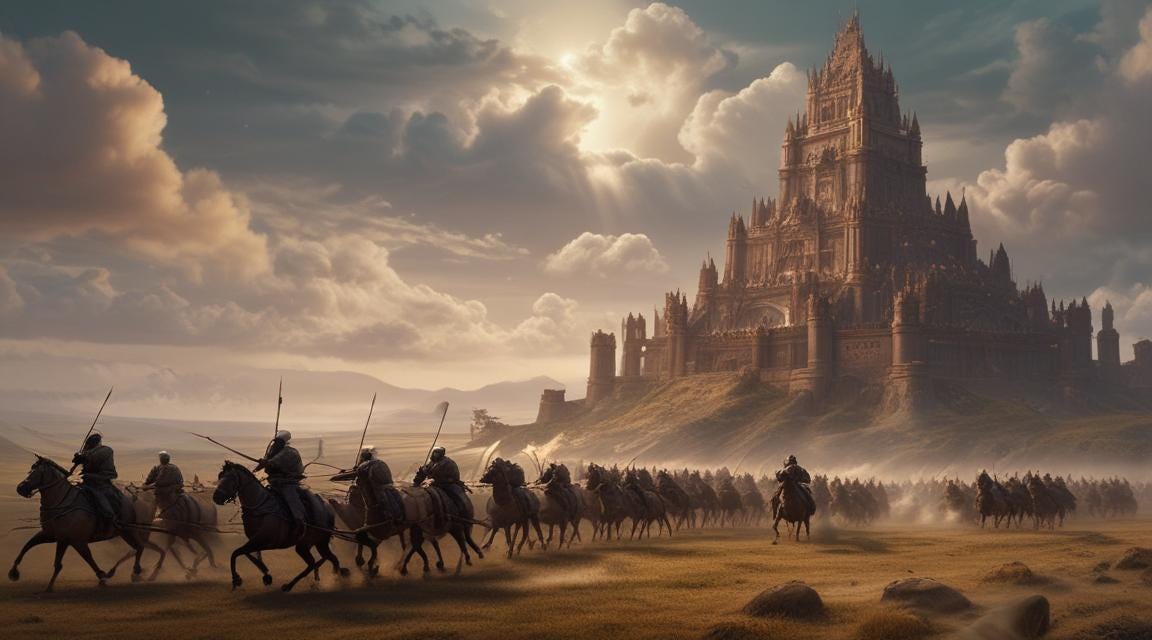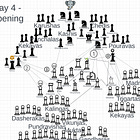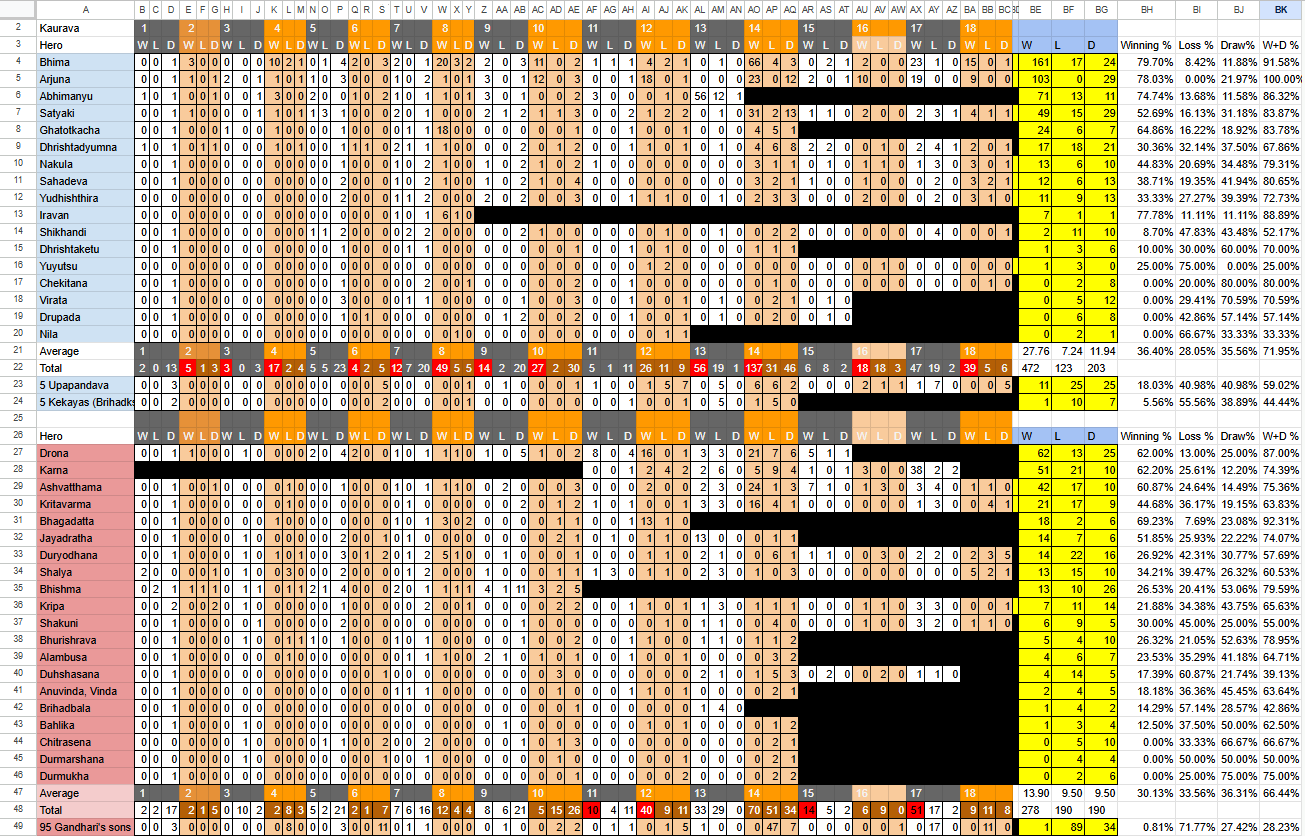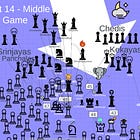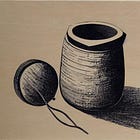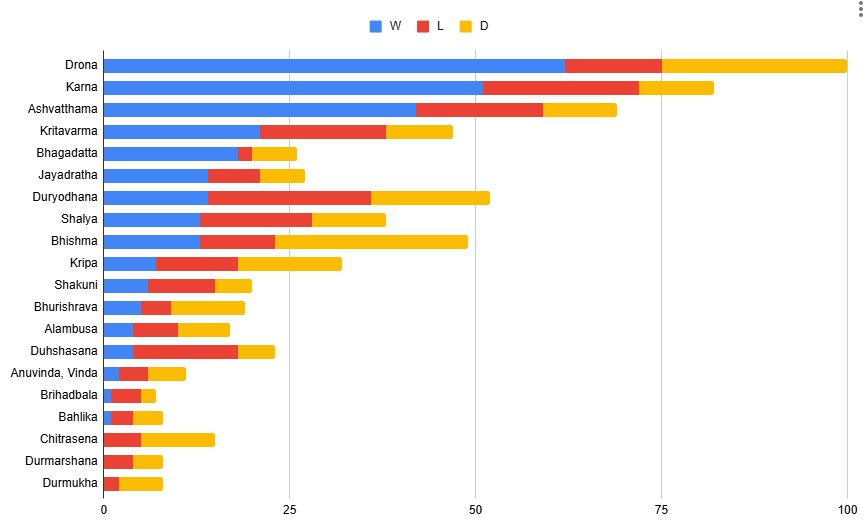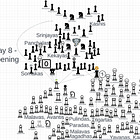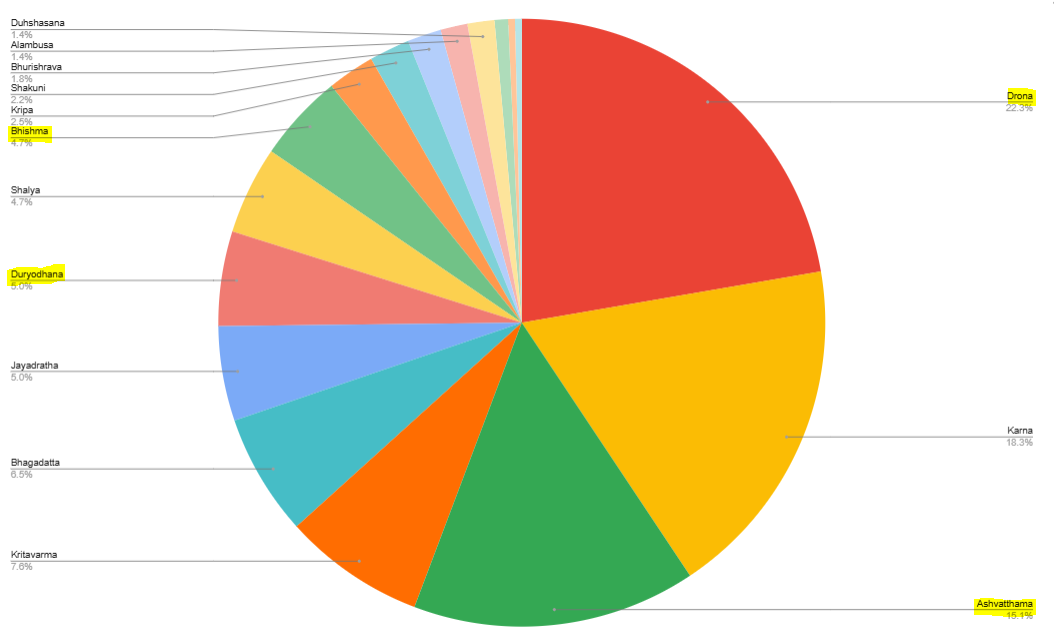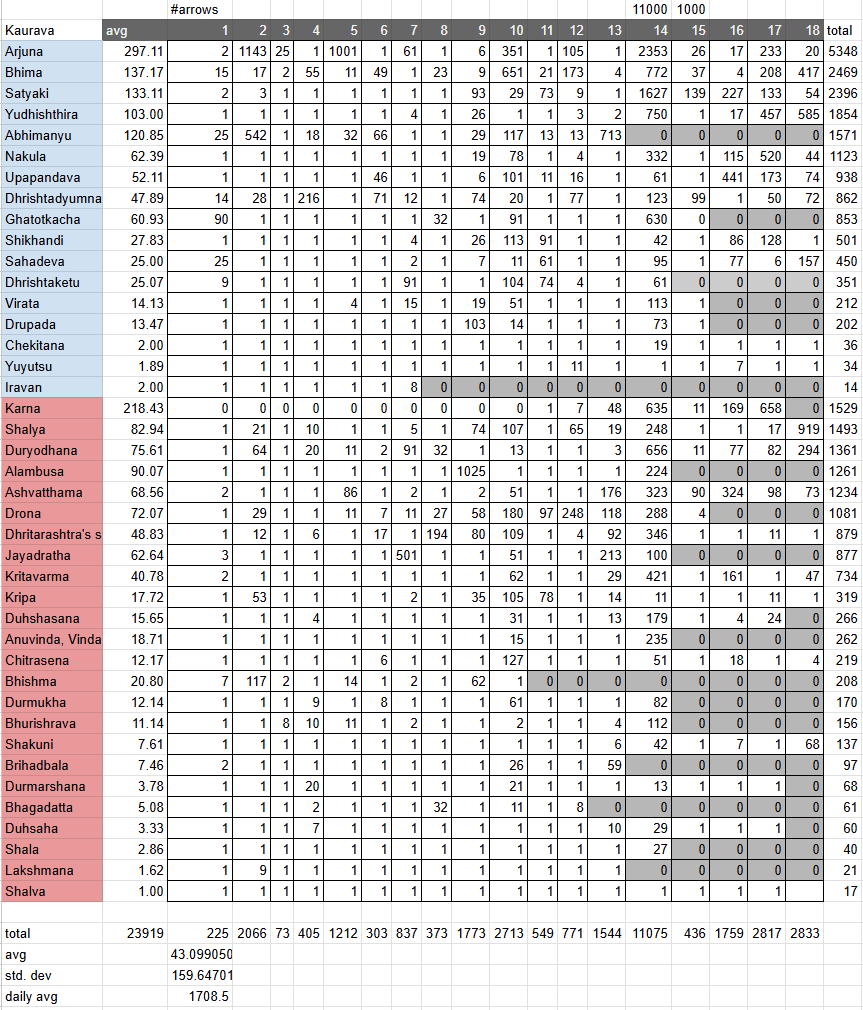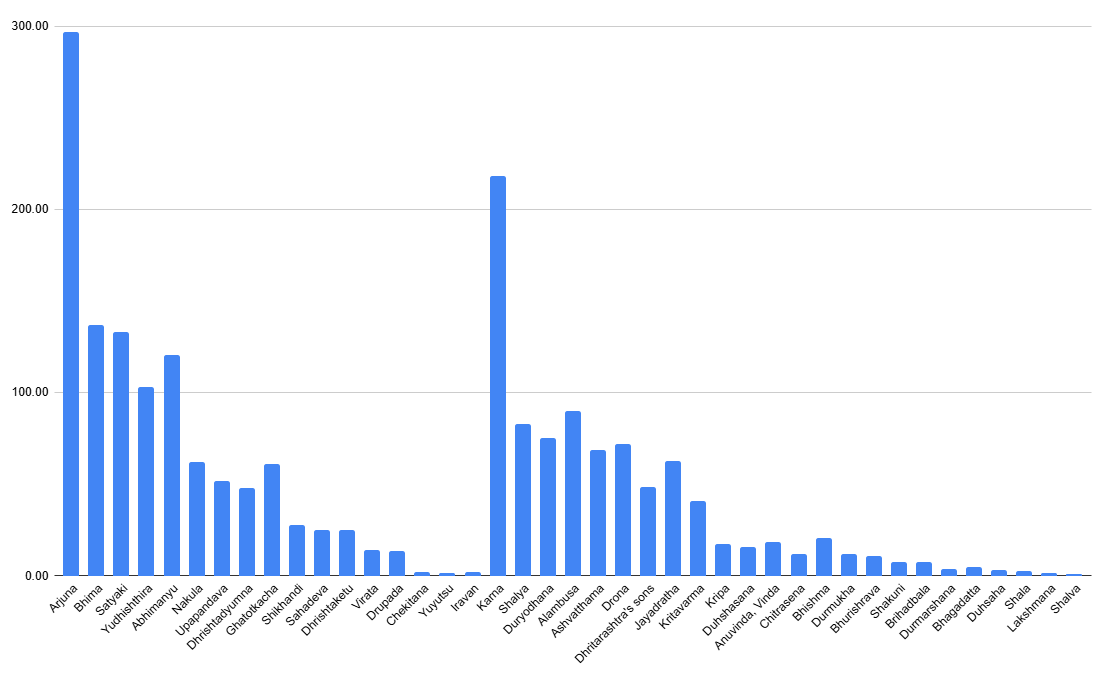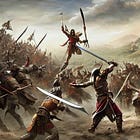Introduction
Part III -
To recap - the data is drawn from the text.
The amount of data a hero has is a composite correlation to the character’s relative importance in plot and prowess on the battlefield. The graphical representations of those characters reflect the many characters relational context.
In part 4 we will use two more metrics to describe the 18-day Mahabharata war.
Metric 1: Wins, Losses And Draws
There are three outcomes in every fight. 2 are positive.
Methodology
In every described fight that takes place in the Mahabharata, we analyzed the text and credited wins, draws and losses according to he criteria.
A loss is counted if a hero is (1) killed, (2) driven from battle (3) forced to flee on another chariot (4) losing badly enough to be rescued by other heroes.
A win is counted similarly and also when a hero drives away an entire army in a way that seems significant. Bhishma, Drona, Arjuna and Bhima are the primary beneficiaries of this win count. In these cases no heroes on the other side may take an L.
Shishupala’s son, Dhrishtaketu, ordered his charioteer to approach Drona after Drona killed the Kekaya prince. Dhrishtaketu pierced Drona, his chariot, and his standard with sixty arrows. Drona used a sharp kshrapra arrow to sever Dhrishtaketu’s bow. Dhrishtaketu picked up another bow. Drona killed Dhrishtaketu’s horses and his charioteer and pierced Dhrishtaketu with twenty-five arrows. Dhrishtaketu was without a chariot or bow. Dhrishtaketu hurled a club. Drona brought the club down with arrows. Dhrishtaketu hurled a javelin. Drona used arrows to shatter the javelin into three fragments. Drona released a sharpened arrow. The arrow passed through Dhrishtaketu’s armor, chest then into the ground. Dhrishtaketu fell down dead. Drona devoured Dhrishtaketu like a hungry blue jay eats an insect. — Bibek Debroy. Jayadratha-vahda. Chapter 178
For the purposes of this conversation, we may count 60 described arrows for Dhrishtaketu, 25 for Drona.
Clearly Drona gets a single win count and Dhrishtaketu a single loss count.
Not every outcome is so clear cut, or every loss so fatal.
Bhagadatta on his elephant crushed the Pandavas. Bhima became angry and attacked Bhagadatta. The elephant sprinkled water from its trunk and frightened Bhima’s horses, which then bore Bhima away from the field. — Bibek Debroy. Samshaptaka Vadha. Chapter 1002.
In this exchange Bhagadatta gets the 1-W and Bhima takes the 1-L.[1]
A draw looks like -
Bhurishrava pierced Satyaki with nine arrows. Satyaki used straight-tufted arrows to repulse Bhurishrava. At this Duryodhana, surrounded by his brothers, surrounded Bhurishrava. In the same way, the Pandavas surrounded Satyaki. — Bibek Debroy. Bhishma Vadha. Chapter 920.
Bhurishrava and Satyaki take a 1-D from this exchange.
[1] Another of Bhima’s losses comes on day 4, when Nandaka knocks Bhima out with an arrow. By the war Bhima may be a little punchy. When Bhima goes down, the Pandavas rally. After Bhima awakes an angry Bhima racks up a mess of wins. This is one of the wins by the Gandhari’s sons.
The Data
18-day totals
These totals may not align with battle shares, which in many cases compresses the individual wins and losses.
Most of Gandhari and Dhritarashtra’s sons are listed in the composite, Durmukha, Durmarshana, Chitrasena, Duhshasana and Duryodhana are specifically listed. The first three are insignificant to plot and battle as individuals but serve as statistical counterparts to the winless Pandavas.
Daily total battles
Pandavas win total battles on 12 days, lose the total on 4, and it’s a push on 2 days.
Total individual wins, loss and draw shares.
Inverse relationship - Wins to Numbers of Forces
The Pandavas win battles (60%) in an inverse proportion to how outnumbered they are.
Here again is how outnumbered the Pandavas are 11-7 in the same format -
I excluded the composite heroes, Upapandavas, Kekayas and Dhritarashtra’s unnamed sons from all averages and sums. Including them would push the Kauravas losses further in the red.
Pandava Box Sheets
The defeated
Characters that never clock a win but have many draws. These characters may be effective in battle in support roles. They may defend or distract. For the Pandavas these include the aged Tier 1 hero Drupada and Virata*, and Tier 4 favorite Nila and Tier 3 Chekitana.
To be clear, draws are positive outcomes. The lesser heroes may not have finishing power, but they can be effective tying up another hero, preventing them from penetrating a vyuha or coming to the aid of another hero in duress.
Win loss and draw stacks
Blue=wins. Red=losses. Orange=draws. Tier 1 heroes highlighted.
The undefeated Hero
Arjuna is the only hero with no losses. On the other hand, Bhima has almost half as many wins again as Arjuna. Granted, Bhima’s share of the fighting is all of Dhritarashtra’s sons, many of whom are named and counted in wins - but here we see a meaningful difference in the two leads.
One way to describe the differences in style may be as a boxing analogy; Bhima is a knockout fighter who will take a hit to give a hit. Arjuna is a prime Muhammed Ali, floats like a butterfly stings like a bee and can’t be hit flush unless he wants to be.
Another way to state the case - Maybe Arjuna could do the things Bhima does, like kill elephants with a club, or jump on chariots and slap other warriors to death, but Arjuna does not need to do that stuff. Maybe Bhima doesn’t have to do those things either, but he does.
Is Arjuna undefeated?
Pandava positive outcomes percentages
Yuyutsu is a Tier 4 character - notable because he is the only one of Dhritarashtra’s sons that fights on the side of the Pandavas. Born to a vaishya maid servant while Gandhari was suffering her two-year pregnancy, Yuyutsu had no love lost with his 100 brothers.
Yuyutsu alone among them survives the war.
Kauravas
Sorted by winning percentage. Bhagadatta is similar to Iravan in this metric - unstoppable right up until he was not.
Kauravas wins-losses-draws.
Kauravas Ranked by wins
Shala pierced each of Draupadi’s sons, great archers, with five arrows and struck them again with seven arrows more. Shatanika pierced Shala with two arrows. Shala shot five arrows back. Shrutakriti used four arrows to kill Shala’s horses. Shrutasoma severed Shala’s bow. Pratavindhya sliced his standard and brought it to the ground. Shrutakarma used a shurapra arrow to sever Shala’s head. — Bibek Debroy. Jayadratha-vahda parva. Chapter 1060
The Upapandavas fight and kill Bhurishrava’s brother, Shala.
Tier Analysis
In Part 3 we delineated three tiers of character based on their importance and battle prowess counted in battle shares.
How well do the tiers hold up with positive and negative context added to the win share equation?
Winning percentage leaders
Some characters, like Iravan, only lose the last battle they fight. Similarly Bhagadatta ends up at the top of the Kaurava winning percentage. These are gung-ho heroes. They don’t back off. This is how it shows in the data.
On the other hand, some heroes fight to live again if they get the worst of it. Their records look like Dhrishtadyumna’s record at 17-18-21. Very active. Dhrishtadyumna hates the Dronas, but he is not as good a fighter as Drona or Ashvatthama, so Dhrishtadyumna takes a lot of losses from them but keeps coming back to attack. Tough, effective, and beatable by the best, but good enough to live to fight again. Very good warrior.
Total win leaders
This is the similar data as battle shares, except that we are only counting battle share wins. The same picture emerges as before except that Abhimanyu and Ghatotkacha have jumped into Tier 1. Abhimanyu’s day 13 was the second biggest of any hero - second only to Arjuna’s performance on day 14 to avenge his death.
The Kauravas -
Karna has an interesting run to the top of the Kaurava battle share win leader board.
Here are all of Karna’s active days.
Until his last day, when Arjuna kills Karna in his last loss, Karna is a losing fighter.
Bhima gives Karna 1 of his 2 losses on his last day, when Bhima knocks Karna out with an arrow. Arjuna gives him the other L.
When Karna loses, he often loses badly. His chariot destroyed, horses dead, no weapons - scrambling to jump on another hero’s chariot.
Before his last ride to glory, Karna loses a lot of duels and demands a rematch after returning on another chariot. Karna lives through many defeats because the Pandavas who defeat him decide to leave Karna to Arjuna, as Arjuna has sworn to defeat him. When Karna loses, he immediately demands a rematch, and another, and another until he gets a win. Before day 17, Karna presents as the sort of hyper competitive male that is not very good but won’t quit asking to rematch in chess or whatever until you let them win.
Metric 2: Described Arrows
Described arrows are volleys with specific numbers attached. Often the number of arrows is not mentioned, but when heroes clash in large engagements, the troops they lead can fire off 10s, 100s or even 1000s of arrows in one volley. The text also specifies number of arrows fired back and forth when the action gets serious during individual duels.
How are described arrows counted?
A representative sample
Kripa used six arrows to kill Yudhishthira’s charioteer. Shalya used his arrows to kill Yudhishthira’s horses. Having destroyed the horses, Shalya began to destroy the warriors who protected Yudhishthira’s flank. Bhimasena attacked Shalya and severed his bow. Bhima pierced Shalya with two arrows. With another arrow, Bhima severed the head of his charioteer. Bhimasena killed Shalya’s four horses. Shalya roamed the field of battle. Bhima’s troops enveloped Shalya with one hundred arrows and so did Sahadeva's. — Bibek Debroy. Shalya-Vadha Chapter 1235
In this encounter a total of 209 described arrows are counted - Kripa:6, Bhima:103, Sahadeva:100. The numbers of arrows Shalya used to kill Yudhishthira’s soldiers and horses is un-described. The first few in an individual clash and the last 200 from two volleys by Bhima and Sahadeva’s troops. For the purposes of this exercise, the counts are un-delineated from volley and duel count.
Outliers
Ashvatthama pierced Krishna with sixty iron arrows and Arjuna three. Arjuna became angry and used three broad-headed arrows to slice down Ashvatthama’s bow. Ashvatthama picked up a bow that was more terrible and strung it an instant. Ashvatthama pierced Vausdeva with three arrows and one thousand for Pandava. Drona’s son shot a thousand arrows, then another one million, and then ten million. Arjuna shattered each of Ashvatthama’s arrows into three fragments, like the wind dispelling a mist. — Bibek Debroy. Karna-Vadha Chapter 1162(12)
In this case, and in one other case for Arjuna on Day 14, when Arjuna opens his assault with 11,000 arrows in his quest for vengeance, I excluded the outlier data. With 10+ millions of counts in his column, obviously this exercise would just be Ashvatthama pie. :)
Sometimes described arrow shares may be a literary device to express a battle’s intensity.
Ashvatthama’s may be the most illustrative case of numerical metaphor - to say Ashvatthama shot thousands and millions of arrows that are easily dispelled is to say Ashvatthama is unravelling - to paint a picture like a modern gunfighter blasting his guns wildly into the air until the chambers are empty.
Context Matters
To quote Wyatt Earp, it’s better to be accurate than fast. Counting arrows is context neutral.
Ashvatthama is not winning here for all his described arrows. Ashvatthama is frustrated and frantic. Sometimes the more described arrows a hero unleashes is an indication they are desperate. By contrast, Arjuna and Bhima coolly bring down numbers of named warriors with a single or 2-3 described arrows. That Arjuna is also the volume leader, even leaving out his 11K outlier, describes Arjuna’s unique prowess similar to his undefeated record.
Described Arrow Dataset
Let’s plot.
Total Arrow Share
Pandavas
Kauravas
Karna is the Kaurava leader in volume and average (below), but Karna compiled most of his described arrows in three days. Just to say Karna showered arrows, but he was not a force day to day. Karna maybe something like a basketball player that could go off on any night, take over the battlefield for awhile, but may coast for games at a time.
Like the Upapandava, Gandhari’s sons are a composite of 90+ Tier 4 brothers to Duryodhana.
Let’s normalize our raw counts to daily averages, as we saw before some warriors fought more days than others.
Avg. Arrow Share
Pies
All Kuru Described Arrows
Taking a look at shares for all characters - again no surprises. The right side are all characters one may expect to be most active.
This graph demonstrates Arjuna’s unquestioned place at the top of the hierarchy; the other side of the story is how often Arjuna uses a single arrow to bring warriors down. Arjuna would be a leader in one arrow shots too, with Bhima right behind.
Pandava Described Arrow Shares
Yudhishthira is far from the best archer, but he is the best and fastest at riding chariots (as described in Sambhava).
Riding a chariot and firing arrows on a battlefield may be something like surfing and shooting at the same time. Without shock absorbers, and making a chariot as light as possible, that buggy bounces over the ground at speed. Yudhishthira was like the best surfer skater and could go faster than others without losing his ability to fight, but he was not the deadliest shot even at a stand still.
Kaurava Described Arrow Shares
Summary & Conclusion
That’s it. This series is done. No more math! We drained it all. Hopefully this may be an interesting visualizing technique that gives insight for other fans of the epic.

